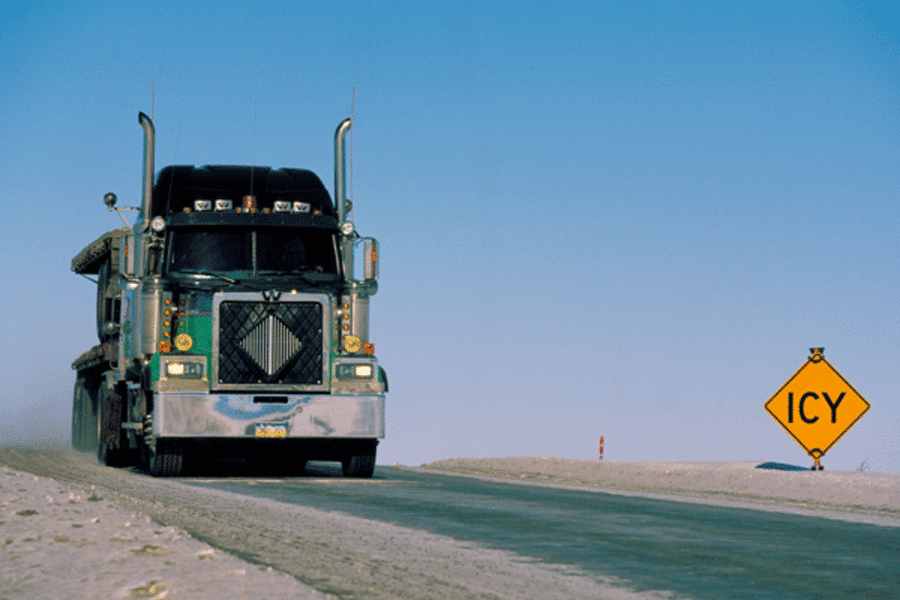Looking for truck driving jobs? How about being an Ice Road trucker?
| Kalispell, Mont.
Ray Veilleux remembers exactly what went through his mind the first time he drove Alaska's notorious Dalton Highway, a ruthless, rugged 414-mile road stretching from Fairbanks to Prudhoe Bay.
"Oh, my God, I'm not sure I can do this," he recalls thinking. "I really wondered if I'd make it."
That was then, about 10 months ago.
Now, Veilleux, 44, is one of the featured truckers on "Ice Road Truckers."
A new 16-week series of the reality show began this month on The History Channel. Veilleux is portrayed as the "rookie" of the bunch, a moniker he rolls his eyes at.
"It's their show," he said. "They can make you out however they want and you gotta play the part, but you work so hard not to be the rookie on that road."
A self-employed Kalispell contractor, Veilleux headed to Alaska in January 2009 after the bottom dropped out of the Flathead's construction industry. After 18 years of making a good living here, he needed a paycheck. The last thing on his mind was becoming a reality-show TV star.
With a lead from one of his daughter's friends, he hired on at Carlile Transportation Systems. It was tough for the 44-year-old to "start at the bottom," but he did it, working in the yard and delivering explosives to area mines, all with the ultimate goal of getting to the Dalton, or Haul Road as truckers call it. That's where the bigger paychecks are. Those who haul the most loads make the most money.
Running the Haul Road isn't something truckers do without prior experience.
"You have to follow another truck for eight trips, to memorize the road," Veilleux explained. "You have to know it by the hills, corners and other features so you can call out on the CB (radio)" to alert the other drivers.
"It's really narrow, like a Forest Service road," he said. "It's a bad, bad road."
The speed limit is 50 mph, and trucks are governed not to go faster than 55. Of course, "downhill you can go a lot faster," he said.
Veilleux's wife, Kim, who admitted she was "scared to death" at times during the height of the haul season, would track her husband by GPS with help from their son, Josh, who also went to work for Carlile.
"If he kept moving, it would be a good sign," she said.
When The History Channel honed in on Carlile truckers for the show's new season, 30 truckers auditioned. Veilleux was one of two chosen.
"I just got lucky," he said. "I got the opportunity to run the worst road in history. It was a hell of an experience."
Veilleux shakes his head over the film crew's antics to create excitement for the action-packed show.
"They want the drama," he said. "They'll egg you on. They want you to bad-talk each other on the radio. They want excitement — it's TV."
Tried-and-true truckers don't much like the Haul Road being glorified for TV ratings, he said.
"All the guys on the Haul Road should be recognized. They're the true ice road truckers," Veilleux said. "For me, my paycheck is how many loads I can get there. I could care less about the 'dash for the cash,'" the network's description of the competition.
Actually, there is no cash reward for the trucker who delivers the most loads. Two veteran drivers, said to have a decades-long rivalry, have been on the show since the onset and are the only ones paid by The History Channel, Veilleux said.
"If I do good on TV and get good ratings, then I may go back up," he said. At that point, it's possible he'd get a paying gig with the show.
Veilleux said he was given the oldest truck with the smallest engine, while other drivers got the bigger trucks, all in the hopes of creating tension and drama among the cast.
Filming lasted from January through March, the Haul Road's busiest season. As rugged as the Haul Road is, it's the true ice roads beyond the turnaround at Deadhorse that can be even trickier. That's where crews actually build up ice to create roads that protect the fragile tundra underneath. The ice can be six to eight feet thick, and drivers tackle frozen rivers and swamps.
"You can't always tell if you're on a river," he said.
Veilleux mostly hauled oil drilling supplies — stem pipe, drill pipe and lots of casing. A load of 59,000 pounds wasn't uncommon.
He also hauled food and supplies to the Eskimo village of Nuiqsut, where residents are stranded for months between the time the ice road melts and another one can be rebuilt.
"It was awesome to go there," he recalled. "At the town hall, they welcomed us" with a feast of native delicacies such as walrus and whale blubber.
The cold was a constant factor. The temperature dipped to 52 below during one of his runs. And blizzards are a way of life. "Phase 3" storms are the worst.
"Some guys get stuck in their trucks for three days," he said. That's not a good thing when time is money.
Crashes are common; so are breakdowns. Drivers have to have the skills to fix their own rigs.
As difficult as the driving was, the hardest part was being away from his family for so long, Veilleux said.
His daughter, Brittany, said she was "worried all the time," but talked to her dad by phone intermittently, and that helped.
Her mother added: "She was in panic mode a lot."
With construction still slow in the Flathead, Veilleux and his son now are employed at an oilfield service company based in Williston, N.D., working two weeks on, one off.
Veilleux is sworn to secrecy about the outcome of this season of "Ice Road Truckers." All he'll say is that it's worth watching.
RELATED:





